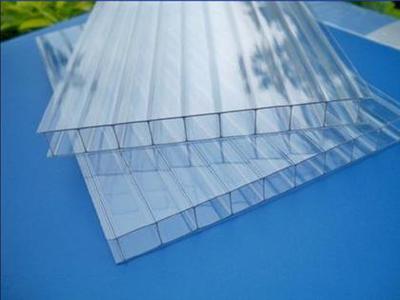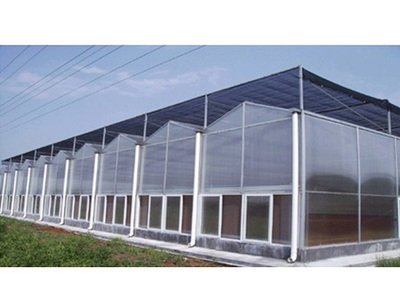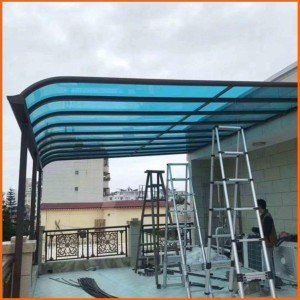Polycarbonate sheets are versatile, durable, and structurally adaptable, making them an essential material across multiple industries. From agricultural applications to commercial architecture, the thickness and structure of polycarbonate sheets determine their best use case. These sheets, available in varying thicknesses—typically from 4mm to 20mm—are engineered to meet specific needs for insulation, transparency, impact resistance, and structural integrity.

Understanding Polycarbonate Sheet Thickness and Structure
Polycarbonate sheets are not just differentiated by thickness, but also by structural design—single-layer, double-layer, triple-layer, four-layer, honeycomb, and multi-wall designs. Each configuration affects the sheet’s thermal insulation, UV resistance, load-bearing capacity, and light diffusion.
Let’s explore how polycarbonate sheets of varying thicknesses are used across different sectors.
1. Agricultural Greenhouses: Harnessing Insulation and Light Diffusion
One of the most prominent uses of polycarbonate sheets is in agricultural greenhouses. These structures require optimal light transmission and thermal insulation to maintain healthy crop growth year-round. For these reasons, greenhouses often utilize:
6mm to 20mm polycarbonate sheets
Double-layer, triple-layer, and four-layer structures
Honeycomb and multi-wall sheets for enhanced insulation
Thicker sheets, such as 16mm to 20mm, are used in colder climates to maximize thermal efficiency, while 6mm to 8mm sheets are preferred in temperate regions where high light transmission is crucial.
Key Benefits:

2. Carport Awnings: Prioritizing Durability and Aesthetic Appeal
Carport awnings benefit from polycarbonate sheets due to their impact resistance, color variety, and cold-bending flexibility. Typically used are:
These awnings are designed not just for function, but also to complement modern architectural styles. Color-tinted sheets in bronze, gray, or blue offer aesthetic harmony while maintaining UV blocking and hail resistance.
Key Features:
Lightweight yet strong
Multiple color choices
Resistance to cracking, bending, or yellowing
Minimal maintenance required
3. Building Skylights and Lighting Panels: Emphasizing Light Transmission
Large-scale buildings—like gymnasiums, airports, and exhibition halls—incorporate polycarbonate sheets into roof lighting systems or vertical lighting strips. These installations demand maximum light transmittance with minimum structural weight.
Typical configurations include:
15mm to 20mm polycarbonate sheets
Four-layer, honeycomb, five-layer, or six-layer constructions
Locking panel systems for added wind and load resistance
Often, clear or lightly tinted polycarbonate is used to allow natural daylight while maintaining UV protection and energy efficiency.
Advantages:
Reduction in energy costs
Long-term structural integrity
High light diffusion with minimal glare
Fire retardant capabilities
4. Garage Entrances, Telephone Booths, and Urban Fixtures
In urban architecture, polycarbonate panels are often employed in transitional spaces like:
These environments benefit from:
8mm to 15mm double-layer or honeycomb sheets
High light diffusion to avoid harsh transitions
Weather resistance and vandalism protection
Design considerations often favor semi-transparent or frosted finishes that allow light while preserving privacy and enhancing visual comfort.
Benefits:
Easy installation and replacement
High impact resistance in high-traffic areas
Resistant to UV, water, and chemicals

5. Interior and Exterior Decoration: Blending Form and Function
Polycarbonate sheets also find increasing use in decorative architectural applications, both indoors and outdoors. These include:
Interior wall cladding
Partition panels
Facade highlights
Backlit signage
For decorative purposes, crystal-clear, textured, or colored polycarbonate panels are often used. Sheet thickness may vary widely depending on structural needs:
What makes polycarbonate ideal for decor is not just its visual appeal, but also its flame retardancy, lightweight structure, and ease of shaping.
Advantages:
6. Noise Barriers and Acoustic Panels: Enhancing Urban Sound Management
Beyond aesthetics and transparency, polycarbonate’s acoustic properties make it an ideal material for sound barriers along highways, railways, and industrial zones.
These structures typically utilize:
The material’s natural density and elasticity allow it to effectively absorb and deflect noise, contributing to improved urban livability.
Benefits:
7. Security Applications: Rigid, Impact-Resistant Structures
In environments requiring heightened security, such as banks, correctional facilities, and laboratories, solid polycarbonate sheets offer unmatched impact resistance—up to 250 times stronger than glass.
Common uses include:
For these applications, thickness ranges from:
Highlights:
Transparent yet shatterproof
Fire-rated and tamper-resistant
Maintains clarity over time
Conclusion: Choosing the Right Thickness for Your Polycarbonate Application
Selecting the appropriate polycarbonate sheet thickness depends entirely on the specific needs of the project—whether it's insulation, transparency, impact resistance, or decorative appeal. From greenhouses to high-security buildings, polycarbonate sheets offer a blend of functionality and flexibility that few materials can match.
As innovation continues in material science, we can expect to see polycarbonate technology evolve even further—supporting more sustainable, energy-efficient, and durable building solutions worldwide.
English
العربية
Français
Русский
Español
Português
Deutsch
italiano
日本語
한국어
Nederlands
Tiếng Việt
ไทย
Polski
Türkçe
አማርኛ
Bahasa Melayu
தமிழ்
Filipino
Bahasa Indonesia
magyar
Română
Монгол
қазақ
Српски
हिन्दी
فارسی
Kiswahili
Slovenčina
Slovenščina
Svenska
українська
Ελληνικά
Suomi
Հայերեն
עברית
اردو
Shqip
বাংলা
Hrvatski
Afrikaans
Māori
සිංහල
Oʻzbekcha
latviešu
Беларуская мова
Bosanski
Български
ქართული
Lietuvių
Malti












